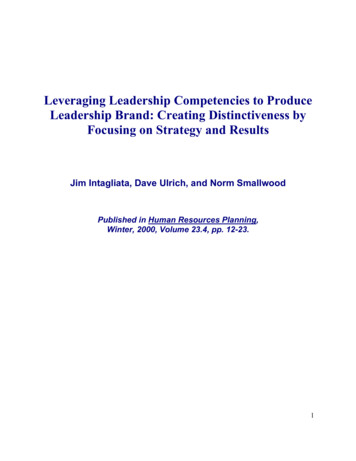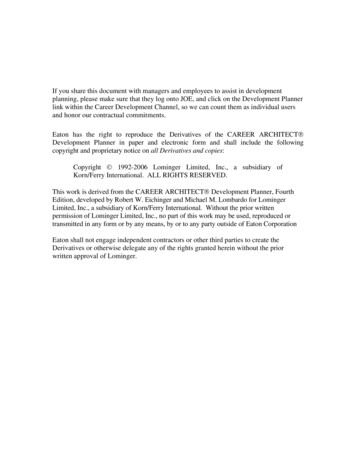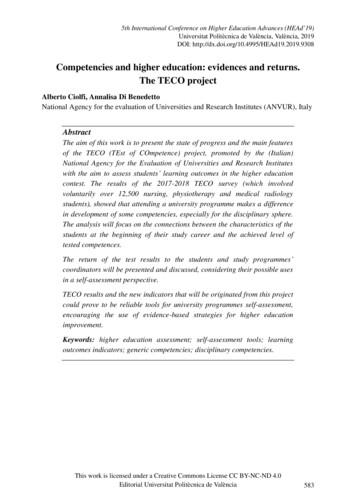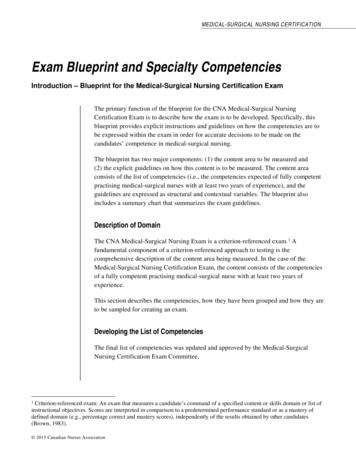
Transcription
Leveraging Leadership Competencies to ProduceLeadership Brand: Creating Distinctiveness byFocusing on Strategy and ResultsJim Intagliata, Dave Ulrich, and Norm SmallwoodPublished in Human Resources Planning,Winter, 2000, Volume 23.4, pp. 12-23.1
Leveraging Leadership Competencies to Produce Leadership Brand:Creating Distinctiveness by Focusing on Strategy and ResultsJim Intagliata, Dave Ulrich, Norm SmallwoodIn a recent article, Ulrich, Smallwood and Zenger (2000) discuss the significant amount ofresearch, time and money that has been invested in the search for a “holy grail” ofleadership attributes. As described by the authors, “This holy grail, when found, wouldidentify a small set of attributes that successful leaders possess, articulate them in waysthat could be transferred across all leaders, and create leadership development experiencesto ensure that future leaders possess these attributes”. Ironically, while leadership mattersmore now than ever and while more money is spent seeking "the true" attributes ofsuccessful leaders, the quality of leadership continues to be a significant concernthroughout the world of business. In survey after survey when executives are asked whatis required for firms to succeed in the future, leadership tops the list. Somehow theinvestment in developing better leaders seems to be missing the desired impact (Ulrich,Zenger, and Smallwood, 1999).We propose that the key to organizations getting a much better return on their investmentin leadership development may depend on their ability to develop distinctive leadershipbrands. In marketing, developing product brand means that the product can bedifferentiated from other products of the same type. To improve product brand, researchersincrease product efficacy while marketers work on advertising. When product efficacy andadvertising are both successful, product brand is attained and the product typicallyachieves a price premium of about thirty percent. Leadership branding refers to the samekind of process. To improve leadership brand, leaders must increase their efficacy ofattaining results while senior leaders “advertise” these results to business publications andWall Street analysts in an effort to manage their reputation. Leadership in a company isbranded when the unique attributes and specific business results are integrated for allleaders within a firm. Over a period of years, an organization may create leaders who arebranded, or distinct from leaders in other firms. Leaders who develop only commonattributes of leadership do not establish leadership brand. What's missing is the notion thatthese attributes need to be ones that clearly link to business results. Since business resultsare firm specific, leadership brand is always unique to a specific firm. When the attributesthe leaders demonstrate are linked to desired results, distinctive branding follows.Leadership brand advances beyond generic competencies or attributes.Microsoft serves as an example. Microsoft leaders have been much in the press lately asthey face government sanctions for monopolistic behavior. Microsoft leaders are knownfor their attributes of high intelligence, their desire to dominate competitors, and their hightechnical competence. Microsoft business results revolve around moving to the Internetand maintaining software ubiquity. So the integration of Microsoft leadership attributesand business results might create a leadership brand statement such as:“Microsoft leaders embody high intelligence, a desire to win in every industry aswell as superior technical competence so that we can successfully transition to2
become a dominant Internet player while maintaining our presence in every softwaremarket.”Why is leadership brand so important? Branded leadership creates a distinct leadershipculture that permeates the entire organization. If this distinct culture is aligned with thebusiness strategy and tightly linked to the desired business results the organization istrying to achieve, it can be a source of competitive advantage. Recent research by Ernstand Young (1998) shows that between 30-45% of investor decisions may be linked to"quality of management." A leadership brand creates value by differentiating a firm'squality of management. Investors are more confident in (and more willing to pay apremium price for) companies that have a track record for delivering results and that alsohave “branded” leaders who instill confidence in their ability to deliver again in the future.Leadership brand occurs when leaders at every level are clear about which results are mostimportant, develop a general consistency about how they will achieve these results, andbuild attributes that align with the achievement of these results. Simply stated, it occurswhen personal attribute building integrates with achieving business results, as captured in asimple but robust definition: effective leadership attributes x results (Ulrich, et al., 1999).Leveraging Competencies to Build Leadership BrandWhy are Competencies Important?This article demonstrates how an organization’s leadership competencies and competencymodels can be turned into leadership brand. Competencies are a critical lever to produceleadership brand within an organization for at least five reasons:1. They guide direction;2. They are measurable;3. Competencies can be learned;4. They can distinguish and differentiate the organization;5. They can help integrate management practices1. Competencies Provide DirectionMost fundamentally, competencies provide organizations with a way to define inbehavioral terms what its leaders need to do to produce the results the organization desiresand do so in a way that is consistent with and builds its culture. They should provide the“North Star” by which leaders at all levels navigate in order to create synergy and producemore significant and consistent results. Competencies alone may provide leaders withdirection, but it is only when they are combined with desired results that they are able toproduce “leadership brand”. For example, a generic competency might be: “VisionaryThinking”. Integrated with a specific result, the competency might become: “Creates andcommunicates a compelling vision for the business so that investors, employees andcustomers understand and are committed to the direction that the organization is headed(as evidenced by investors’ buying more stock, employees working harder or not jumping3
at other job offers, and customers’ loyalty to the company’s products/services).”Direction is strongest and most clear within organizations when competencies explain notonly what or how to do something, but why.2. Competencies (and competency development) are MeasurableA second reason for the importance of competencies in building leadership brand is that,when properly defined, they (and the impact they have on desired results) can bemeasured. This measurability enables organizations to evaluate the extent to which theirleaders are demonstrating the behaviors believed to be critical for success as well as toassess the business-relevant return on resources invested to attain or develop thesecompetencies in their leaders. In leadership development efforts, the effectiveness ofmanagers in developing or demonstrating key competencies is now routinely beingmeasured with powerful 360 feedback instruments that enable these individuals tocompare their self-perception to that of their boss, peers and subordinates (Chappelow,1998; Dalton, 1998; Dalton and Hollenbeck, 1997; Tornow, London, & CCL Associates,1998). If I get feedback on how “visionary” I am perceived to be and I think I am “highlyvisionary” whereas others see me as “not visionary” that is important to know. The abilityto know if individuals are demonstrating the behaviors judged to be critical for producingthe organization’s desired results and/or are making progress in developing them (asjudged by follow-up measurement) is a critical aspect of being able to strengthen anorganization’s leadership brand. If the measurement of competency development progressis also coupled with the measurement of the impact of these competencies on businessresults this heightens the organization’s capability to progress in its development ofleadership brand.3. Competencies Can be LearnedA third reason is that competencies can be learned. This means that if an organizationdetermines the kind of leadership behaviors critical for its success they can enhance theirsuccess in creating leadership brand by taking steps to develop the capability of theirleaders to demonstrate these competencies on-the-job. Unlike personality traits,competencies are characteristics of individuals that are (relatively more) malleable-theycan be developed and improved. Continuing our example from before, now that I knowthat I am not perceived as very visionary by my colleagues, I need to learn anddemonstrate some more visionary behaviors. There are lots of ways I could do this: Hold more meetings where I review where we’ve been, where we are, andwhere we are going in the future; Take a speech making class where I learn how to come across as more decisive; Get a wardrobe consultant and change my clothes and haircut to look more likevisionary people I know; Etc.4. Competencies Can Distinguish and Differentiate the Organization4
A fourth reason why competencies are important for developing leadership brand is thatthey represent a behavioral dimension on which organizations can distinguish anddifferentiate themselves. While two organizations may be generally alike in the kinds offinancial results they achieve (as well as results related to their employees, customers, etc.)the way in which they accomplish this can vary depending on the competencies that fittheir particular strategy and culture. Having a brand that is differentiated can enhance itsvalue. Steve Jobs is a great example of integrating the vision of a company with the visionof a person. Apple seems visionary again, because it is associated with Steve Jobs whogets a lot of PR for being visionary. Actually delivering some visionary new productshelps a lot too.5. Competencies Can Integrate Management PracticesFinally, competencies are important for producing leadership brand because they canprovide a structured model that can be used to integrate management practices throughoutthe organization. With competencies appropriately defined, organizations can align theirrecruiting, performance management, training and development and reward practices tobuild and reinforce key valued behaviors. Employees in many organizations can feelpulled in multiple directions when HR practices reinforce and demand competingpriorities. If employees and their managers are responding to “mixed signals” about whatis important within the organization their capability in producing a recognizable anddistinct leadership brand is diminished.What is Wrong (or Lacking) with Current Competency Models ?Most organizations are concerned about leadership and leadership development.Following the guidance of leading competency modeling practitioners, many havedeveloped their own competency models or architectures to define the overall leadershipbehaviors expected in their culture and, in addition, may have invested in the creating anumber of additional job or role-specific models (Boyatzis, 1982; Dubois, 1998; Linkage,1997, Lucia and Lepsinger, 1999; Spencer, McClelland & Spencer, 1990; Spencer andSpencer, 1993; Parry, 1996; Raelin and Coolidge, 1996) . These models typically define10-25 key behaviors that effective leaders are expected to develop and demonstrate and arebecoming fairly commonplace in corporate America. Despite the significant investmentsmany organizations have made in competency modeling efforts, the models produced havenot necessarily helped them to reach their goal of developing the leaders they want andneed (much less created for them a distinctive leadership brand that could lead theinvestment community to attribute greater value to their company). Why is this so? Thereare five fundamental reasons.1. Competencies are Focused More on Behavior than ResultsMost organizations that have competency models have taken the approach of defining eachcompetency in terms of how leaders are expected to behaviorally demonstrate it, but stopshort of explaining why demonstrating it has business relevance. As a result,competencies often end up being perceived as “soft” stuff (all about style, not substance).5
Part of the reason this occurs is tied to how the competencies themselves are oftendeveloped or “chosen” for the organization.One of the best approaches to competency modeling involves a rigorous comparativeanalysis of “star” and average performers in order to “cull out” the few powerfulbehaviors that actually account for the significant differences in performance between thetwo groups. While it is possible to develop competency models in ways that strongly linkthem to the results that a particular organization needs to attain, such methodologies can betime-consuming and expensive to implement. Many organizations make the decision todevelop their competencies more quickly and less expensively.Examples of competency modeling that are fairly typical and not as rigorous include: using focus groups or expert panels of employees to employ an open-ended process todiscuss and identify what competencies the “experts” believe are important for gettinggood results, simply asking focus groups to rank-order the relative importance of a pre-determinedset of generic competencies (e.g. Lominger Career Architect, 1992) and pick those theyfeel are most critical in their organization, or simply picking an already developed competency model because it looks complete anddescribes leadership behavior in a way that organizational leaders feel makes sense(e.g. , Covey’s Seven Habits (Covey, 1989) or Goleman’s Emotional Intelligence(Goleman. 1998).While these methodolog
Competencies Can Distinguish and Differentiate the Organization. 5 A fourth reason why competencies are important for developing leadership brand is that they represent a behavioral dimension on which organizations can distinguish and differentiate themselves. While two organizations may be generally alike in the kinds of financial results they achieve (as well as results related to their .











